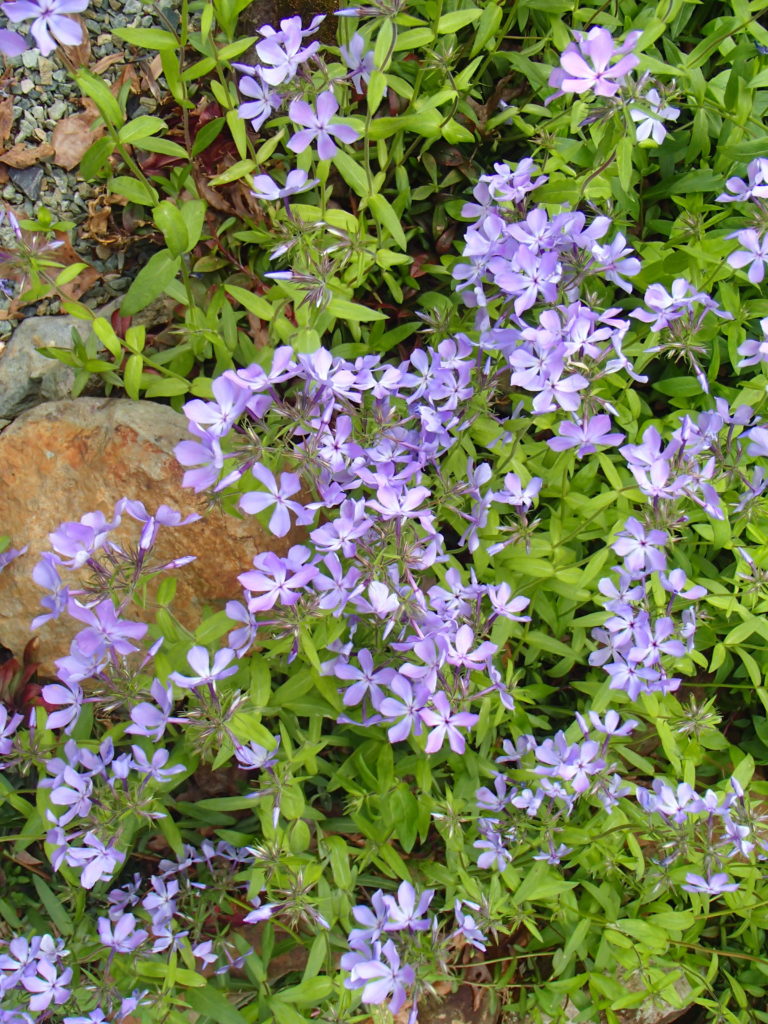Wild Sweet William or Woodland Phlox is a beautiful and beloved wildflower that can brighten a shady area in need of spring color, — ranging from a soft exquisite true blue to lavender and occasionally, white. It occupies a position between the low groundcover phloxes and the tall garden phloxes. During its vegetative growth, Woodland Phlox remains a low, sprawling, deep green, groundcovering colony (even in winter), usually remaining shorter than a foot. However, when it begins to flower — and it is a valuable early season nectar source — it sends up stalks that can reach 18 inches or more of the superb, soft blue, supporting many long-tongued pollinators. These flowering stalks usually last between 4 to 6 weeks before dying back, leaving the non-flowering shoots to accumulate energy for the next season’s show. Woodland Phlox does self sow as well as rooting at the nodes of prostrate stems, making it ideal for naturalizing, but it is not difficult to contain. Although it is a woodland plant, some exposure to dappled sun will keep P. divaricata free of mildew in the garden. Planted in rich, moist, organic soil in partial shade locations, this long lived species can be a stunning addition to the garden or naturalized area.
NURSERY HOURS
Wednesday: 10-4 Thursday: 10-6 Friday-Saturday: 10-4 Sunday: 12-4
Phlox divaricata

Key Info
Common Names: Eastern Blue Phlox, Louisiana Phlox, Blue Woodland Phlox, Sweet William, Wild Sweet William
Family Names: Polemoniaceae (Jacob's Ladder Family)
Plant Type: Herbaceous perennial
Leaf Retention: Evergreen
Flower Color: Blue, Lavender, White
Special Characteristics: Flowers fragrant, Long lived, Evergreen, Attracts butterflies, Rhizomatous, Long blooming
Additional Info
Habit: Woodland Phlox has both fertile and infertile shoots. The shallow root system produces stolons which form a mat of non-flowering shoots about 12 inches in height. The leafy shoots, when prostrate, will root at the nodes, a second way to expand the colony. The fertile or flowering shoots are taller (up to 18 inches tall), unbranched, and more densely pubescent, and sticky. After flowering and seed formation, these fertile shoots die back, leaving the mat of nonflowering foliage which persists through winter.
Height: 12-18"
Spread: 1'
Soil Conditions: Rich, moist, acid soils, but also found in calcareous areas. Sandy, Sandy Loam, Medium Loam, Clay Loam, Clay.
Leaves: The unstalked leaves of the fertile (flowering) shoots are opposite, lance-shaped to ovate, pubescent and up to 2½ inch long by ¾ inch across. The margins of the leaves above are smooth and fringed with hairs. The infertile shoots have slightly more rounded leaves, opposite, sessile, hairy, lance-shaped to elliptical, up to 2” long with entire margins.
Flowers (or reproductive structures: Flowers of Woodland Phlox range from true blue to lavender, pinkish and white. They are fragrant, about an inch across, and occur in loose, flat clusters at the top of the plant. For Phlox divaricata spp. divaricata, the petals are notched (For ssp. laphamii, a more Western form, the flowers lack the notch.) Although the flower presents five flattened petals, these are fused at the base into a narrow, recessed tube containing five stamens and a single pistil ("salverform" flowers), subtended by a hairy green or reddish green calyx with 5 linear teeth.
Fruit: The rounded fruits starts out green and eventually dry to brown, ovoid seed capsules containing several small black seeds.
Natural Distribution: Moist, rich, deciduous woods and bluffs. It can survive minor, but not severe, degradation of woodland habitat.
USDA Hardiness Zone: 3 to 8
USDA Wetland Indicator Status in NC: FACU
Pollination: Woodland Phlox is self-incompatible, so it requires cross-pollination to produce seed. Pollinators include only long-tongued insects (butterflies, especially Tiger Swallowtails, Skippers, Hummingbird Clearwing and Sphinx Moths, as well as Grey Hairstreaks and Western Pygmy Blues) and bumblebees, which are able to reach the nectar produced at the base of the long corolla tube (wimastergardener.org and Illinoiswildflower.info)
Wildlife Connections: Attracts butterflies, moths, bees and flies. The flowers are visited by many other insects that feed on the pollen produced near the upper end of the tube. Roots are consumed by rabbits and voles and the foliage is nibbled by deer.
Propagation: By seed, by division (detach rooted stems in spring or early fall), basal cuttings taken in spring, or root cuttings taken in early fall.
